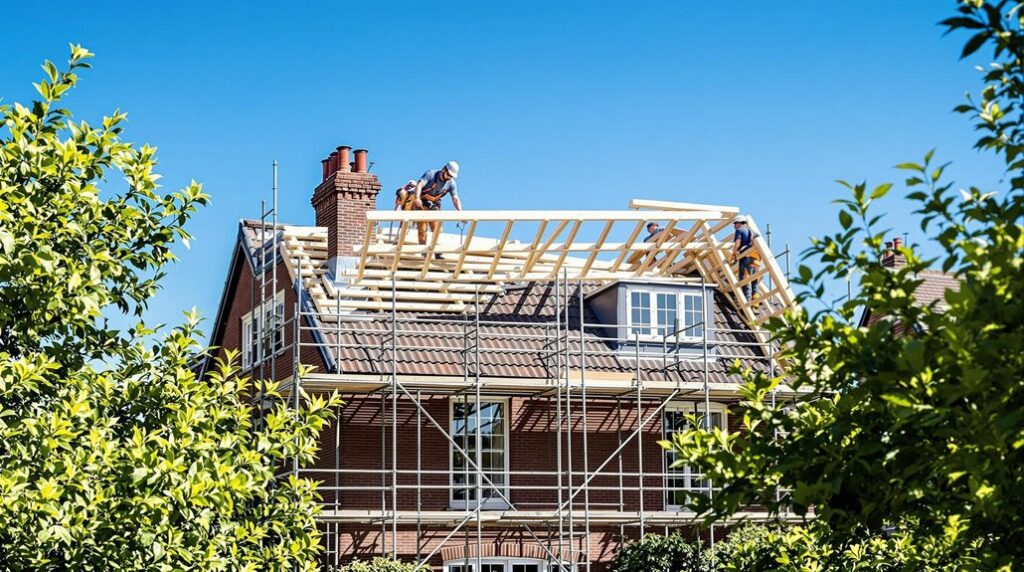I’ve helped countless UK homeowners navigate the complex world of roof extension costs, and I can tell you that understanding the true financial picture isn’t as straightforward as most builders make it seem. While you’ll find estimates ranging from £1,200 to £2,500 per square metre for flat roof extensions, the reality involves hidden expenses that can quickly spiral your budget out of control. Before you commit to any contractor or design, there’s a critical cost breakdown you need to understand first.
Key Takeaways
- Roof extension costs range from £1,200-£2,893 per square metre, with pitched roofs costing 35-50% more than flat roofs.
- Regional pricing varies significantly: London costs £2,589/m², while North England offers the most affordable rates at £2,258/m².
- Double-storey extensions cost 60-100% more than single-storey but provide 20-25% increase in property value.
- Prefabricated options range £1,200-£3,000 per square metre, offering faster installation and reduced on-site disruption.
- Include 15-20% contingency budget and expect 6-12 months planning plus 8-16 weeks construction time.
Understanding Roof Extension Costs Per Square Metre
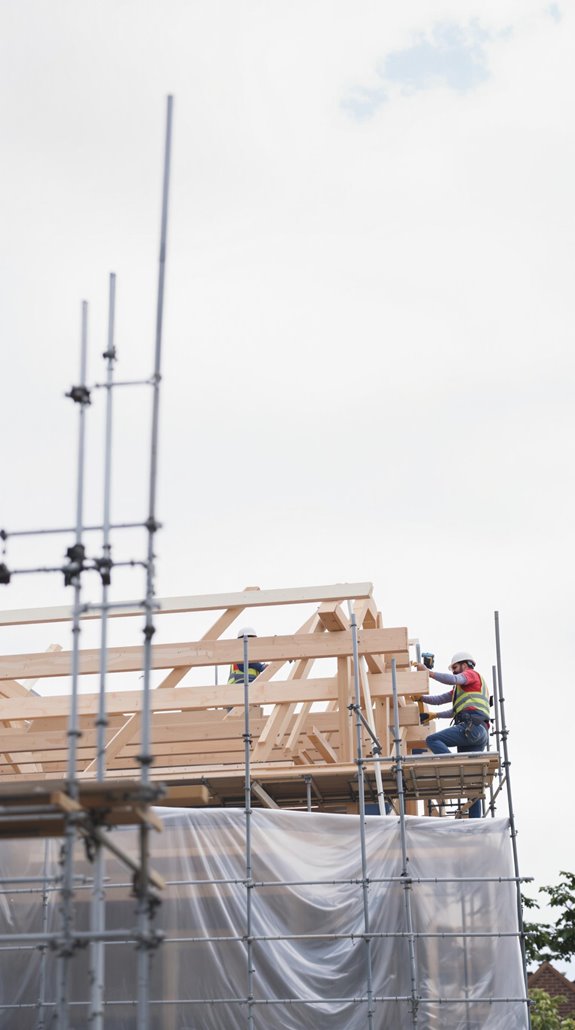
Understanding roof extension costs per square metre becomes essential when you’re planning your budget and comparing different construction options. I’ve found that flat roof extensions typically cost £1,200-£2,500 per m², while pitched roofs range from £2,070-£2,893 per m². This means you’ll pay 35-50% more for pitched roofs due to their structural complexity. Additionally, it’s crucial to consider permitted development rights when planning your extension to ensure compliance with local regulations.
Prefabricated extensions offer the most cost-effective solution at £1,200-£1,700 per m², delivering consistent pricing regardless of project size. The labour component accounts for £850-£1,125 per m², while materials range from £225-£1,400 per m².
Your location greatly impacts costs, with London prices reaching the upper ranges. Most projects require 8-10 weeks to complete, which affects both labour scheduling and temporary accommodation costs. I recommend calculating your total budget by multiplying your desired square footage by these per-metre rates, then adding 15-20% contingency for unexpected expenses.
Regional Price Variations Across the UK
When you’re planning a roof extension, location dramatically affects your budget, with costs varying by up to £20,000 across different UK regions. London commands premium pricing at £2,589 per m², creating a 9% premium over other areas. The South East follows closely at £2,574 per m², making it the second-costliest region.
If you’re seeking better value, East Anglia offers moderate pricing at £2,388 per m², while the Midlands provides mid-range costs at £2,316 per m². North England delivers the most affordable rates at £2,258 per m², potentially saving you thousands compared to southern counterparts. A well-planned double storey rear extension can also enhance the overall value of your home.
Understanding these regional differences helps you budget accurately and potentially consider timing your project around location factors that directly impact your total investment. Remember that these figures exclude VAT and additional expenses such as planning permission applications, which can add further costs to your project.
Single-Storey Vs Double-Storey Extension Pricing
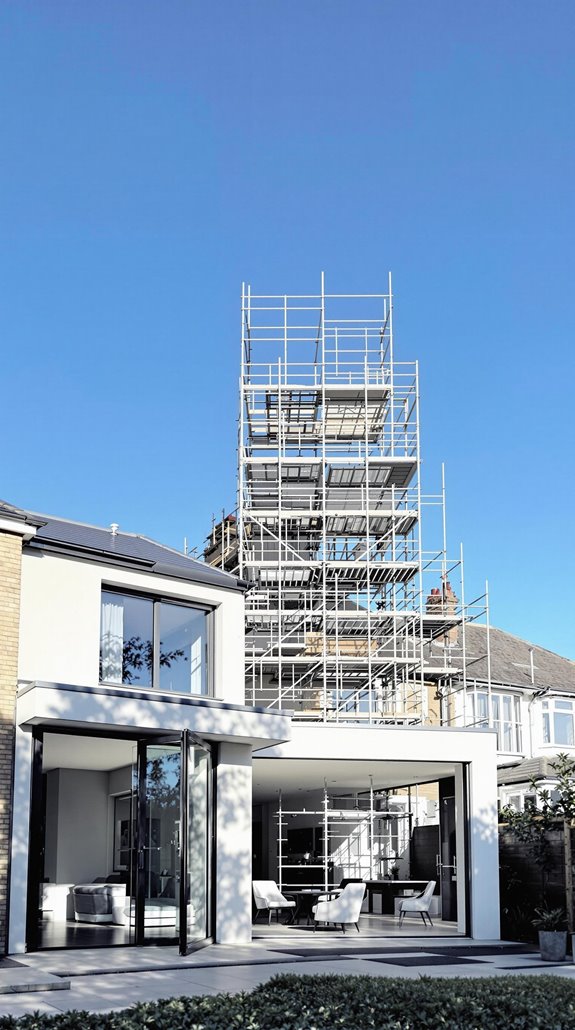
Beyond regional pricing differences, the choice between single-storey and double-storey extensions creates the most significant budget impact on your project. I’ve found that single-storey extensions cost £30,000–£60,000 for 20–30m², while double-storey projects demand £108,000–£180,000 for 60m² – that’s 60–100% higher budget allocation you’ll need.
The structural complexity drives these costs. Double-storey builds require deeper foundations, reinforced structures, and specialised labour that increases costs by 30–40%. You’ll also face longer timelines – 12 weeks versus 4–6 months – plus additional Party Wall Agreements and Building Regulations fees. Professional project management can help reduce these elevated costs by 15-25% through efficient coordination of labour and materials. Understanding regional price variations is crucial in estimating the overall budget for your project.
However, double-storey extensions deliver superior ROI at 20–25% property value increase compared to single-storey’s 10–15%. The choice depends on your budget capacity and space requirements.
Prefabricated Roof Extension Options and Costs
Since prefabricated roof extensions offer significant cost advantages over traditional builds, you’ll find these factory-built solutions deliver 25% savings while maintaining structural integrity. I’ve analyzed current market pricing, and you’ll pay between £1,200 and £3,000 per square metre for prefab roof extensions.
For practical budgeting, expect small extensions (15m²) to cost £18,000-£45,000, while medium projects (25m²) range from £30,000-£75,000. Premium features like integrated bathrooms or kitchens can push costs up to £65,000.
The cost structure breaks down clearly: basic units start at £1,200 per square metre, standard quality averages £1,500-£1,700, and premium options reach £3,000. You’ll benefit from reduced on-site disruption, faster installation, and lower project management costs compared to traditional construction methods. Precision-engineered panels are manufactured off-site, which significantly reduces both labor requirements and build times. Additionally, many homeowners find that planning permissions can vary based on the size and scope of the extension, so it’s essential to check local regulations early in the process.
Key Factors That Impact Your Extension Budget
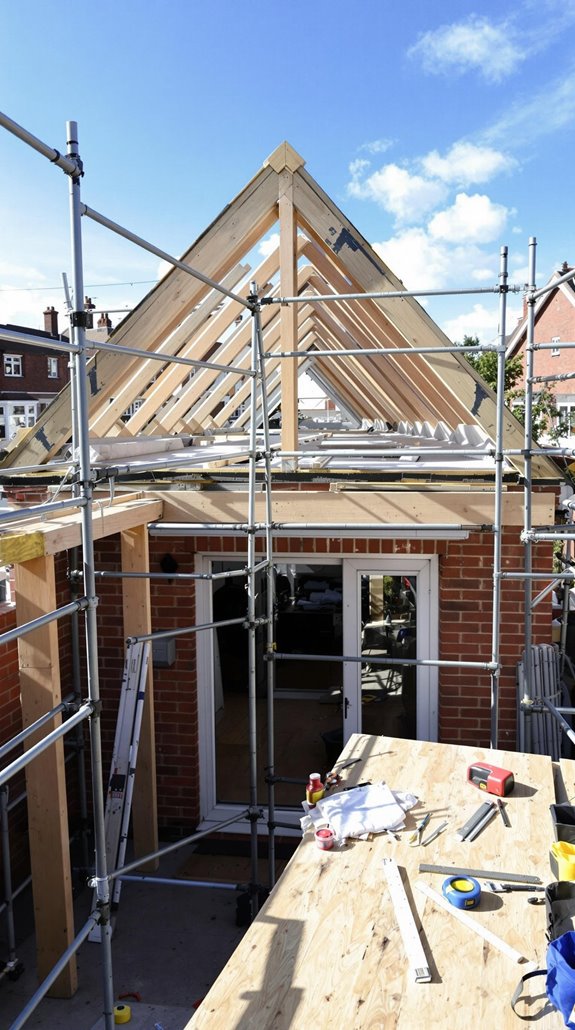
While prefabricated options offer clear savings, I’ll show you how five critical factors determine your extension’s final cost.
Size drives everything – you’ll pay £2,200-£3,300 per square metre, meaning a 25m² extension costs £30,000-£42,500.
Location matters greatly – London commands £2,893/m² versus £2,070/m² in North England, with urban areas adding 15-20% premiums over rural locations.
Material choices impact your budget directly – wood reduces costs by 37.5% compared to uPVC, while brick and aluminium increase expenses by 15-20%.
Design complexity adds substantial costs – non-rectangular layouts increase budgets by 15-30%, pitched roofs add 10-15%, and custom features like skylights cost £50-£100/m² extra.
Labour and professional fees comprise 25-45% of total costs, with architect fees taking 10-15% of your budget. Remember to include a 10% contingency in your budget for unexpected issues that commonly arise during construction.
Planning Permission and Legal Requirements
Although your roof extension project might seem straightforward, you’ll face strict legal requirements that can derail your timeline and budget if ignored. I’ll help you navigate these complexities so you’re not caught off-guard.
First, you’ll need planning permission for extensions over 40m³ (terraced houses) or 50m³ (detached/semi-detached). You’re exempt from permitted development if you own a flat, maisonette, or live in conservation areas. Your extension can’t exceed the original roofline height or extend beyond the front roof plane. It’s essential to check the planning permission criteria to ensure compliance with local regulations.
The application process takes eight weeks minimum, costing £206 for householder applications. You’ll also need separate Building Regulations approval (£150-£500) and potentially Party Wall agreements if affecting neighbors. Remember that Building Regulations approval ensures structural integrity and safety requirements are met, even when your project falls under permitted development rights.
Professional consultation prevents costly rejections and enforcement actions.
Timeline Expectations for Roof Extension Projects
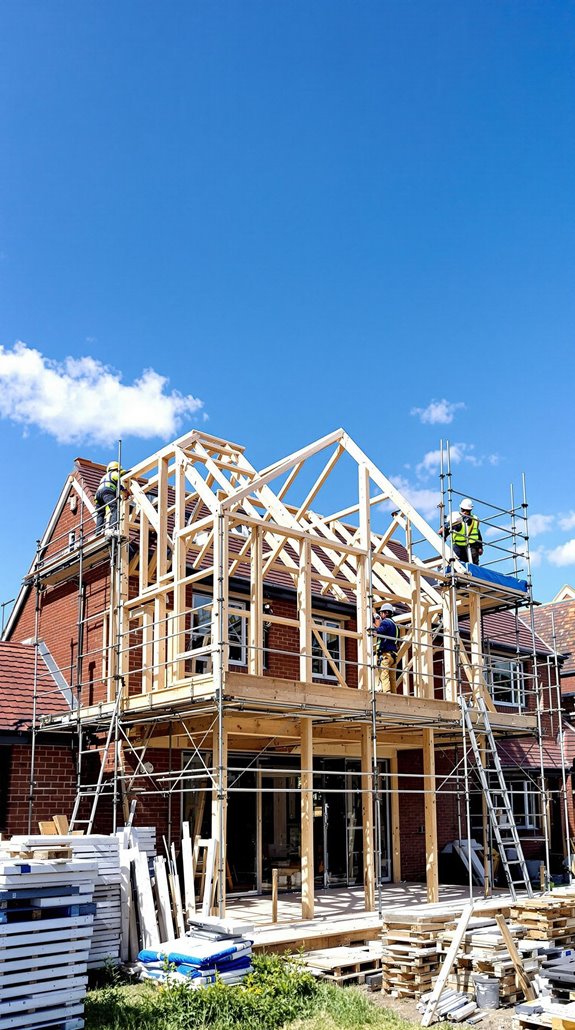
Understanding your roof extension timeline prevents costly delays and helps you plan around major construction disruptions. I’ll break down the realistic timeframes you’re facing.
Pre-construction planning typically spans 6-12 months. You’ll need one month for feasibility studies, 1-2 months for architectural design, and 3-4 months for planning permission. Technical design and building regulations approval add another 4-6 months, ensuring compliance with building regulations that safeguard your investment.
The actual construction phase runs 8-16 weeks for most roof extensions. Structural work, including steel beam installation, takes 2-3 weeks. Roof construction and waterproofing require 3-4 weeks. First fix work (electrics, plumbing) needs 2-3 weeks, while finishing touches consume the final 3-4 weeks.
Weather delays can extend timelines by 2-4 weeks during winter months. Planning for these contingencies protects your budget and sanity. Industry experts recommend preparing a contingency budget of 10-15% of your total project cost to handle unexpected issues that commonly arise during construction.
Cost-Saving Strategies for Budget-Conscious Homeowners
Since roof extension costs can quickly spiral beyond your initial budget, implementing proven cost-saving strategies becomes crucial for project success. I’ll share five strategic approaches that’ll keep your project financially viable.
First, embrace design simplicity—rectangular footprints and flat roofs dramatically reduce construction complexity and material waste. Also, ensuring your design complies with local building regulations can help avoid additional costs associated with modifications. Second, choose cost-effective construction methods like suspended timber floors over concrete alternatives, which eliminates expensive excavation work. Third, I recommend obtaining multiple detailed quotes from contractors to guarantee competitive pricing and identify potential savings.
Fourth, maximize existing infrastructure by aligning your extension with current plumbing and electrical systems, avoiding costly relocations. Additionally, consider reducing window quantities strategically since glazing costs significantly more per square meter than standard wall construction. Finally, time your project strategically—building during spring and summer months prevents weather-related delays and winter premium costs that contractors typically charge during harsh conditions.
Material Choices and Their Financial Impact
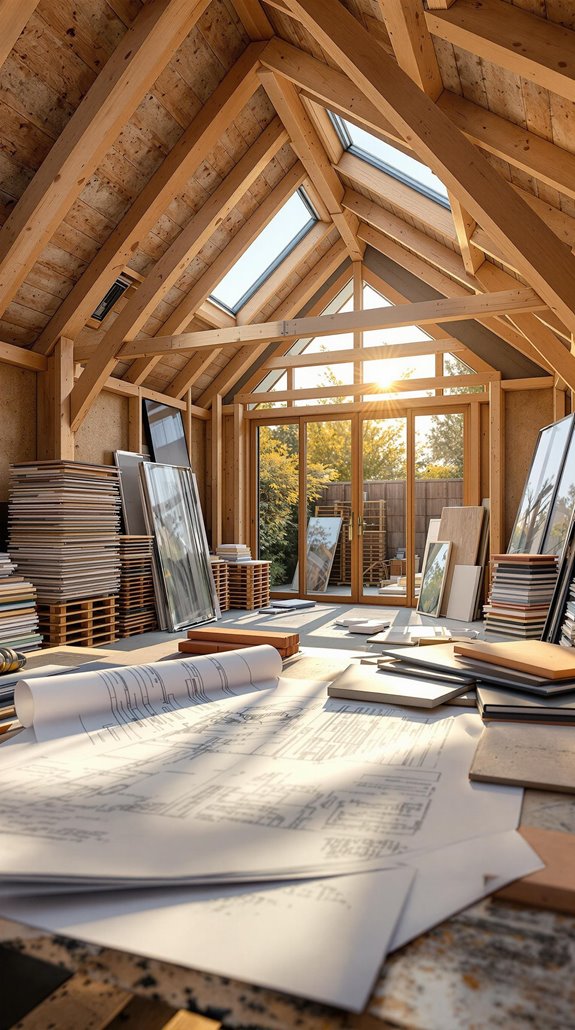
Beyond implementing smart cost-saving strategies, your material selections will dramatically impact both upfront expenses and long-term financial obligations. I’ll break down the key financial considerations for each roofing material type.
For flat roofs, you’ll face significant cost variations: felt costs £350-700 per m² but requires replacement every 10-15 years, while EPDM rubber (£700-1,050 per m²) lasts 30-50 years. Fibreglass offers the longest lifespan at £1,050-1,400 per m². Choosing durable materials will not only enhance the extension’s longevity but also ensure it withstands the test of time.
Pitched roofs present different economics: concrete and clay tiles cost £120-230 per m², while natural slate commands £160-275 per m² but delivers 100+ year durability. Though slate increases upfront costs by 30-50%, you’ll eliminate replacement expenses entirely, making it the most cost-effective long-term choice for serious homeowners.
Quality materials combined with expert installation ensure your roof extension delivers maximum longevity and durability for your investment.
Conclusion
I’ve shown you the key cost drivers for roof extensions, from £1,200-£2,500 per square metre for flat roofs to £108,000-£180,000 for double-storey builds. You’ll control costs by choosing prefabricated options, comparing regional pricing, and selecting materials strategically. Don’t forget planning permission requirements and realistic timelines. By understanding these technical factors and implementing the cost-saving strategies I’ve outlined, you’ll maximize your investment while adding valuable space to your property efficiently.
References
- https://buildpartner.com/how-much-does-it-cost-to-build-an-extension-in-2025-a-uk-guide/
- https://www.homebuilding.co.uk/advice/how-much-does-an-extension-cost
- https://nabc.org.uk/how-much-does-an-extension-cost-in-2023/
- https://www.myjobquote.co.uk/costs/house-extension
- https://buonconstruction.com/cost-to-build-an-extension-uk/
- https://www.myjobquote.co.uk/costs/flat-roof-extension
- https://www.checkatrade.com/blog/cost-guides/flat-roof-extension-cost/
- https://devisarchitecture.com/home-extensions/modern-flat-roof-extension-in-the-uk-a-complete-guide/
- https://www.checkatrade.com/blog/cost-guides/house-extension-cost/
- https://www.mpreed.co.uk/how-much-does-a-home-extension-cost-in-2025-a-breakdown-of-expenses

